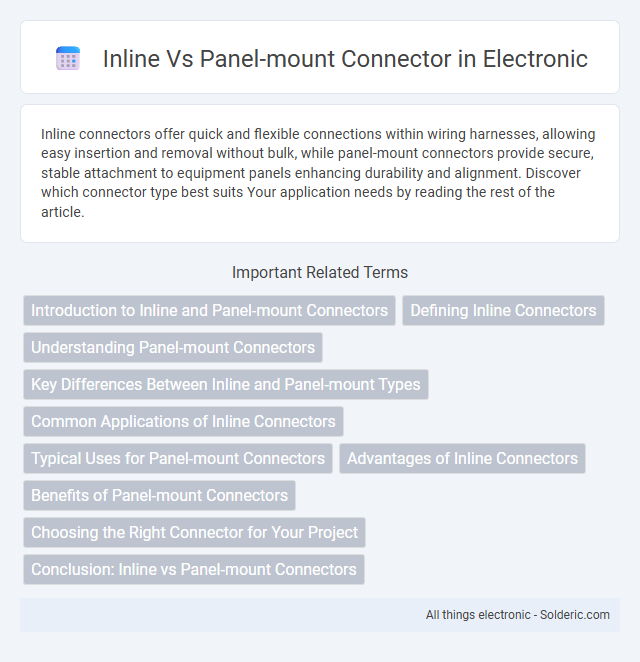Inline connectors offer quick and flexible connections within wiring harnesses, allowing easy insertion and removal without bulk, while panel-mount connectors provide secure, stable attachment to equipment panels enhancing durability and alignment. Discover which connector type best suits Your application needs by reading the rest of the article.
Comparison Table
| Feature | Inline Connector | Panel-Mount Connector |
|---|---|---|
| Installation | Connected directly between two cables | Mounted onto a panel or chassis |
| Application | Extension or repair of cables | Fixed mounting for devices or equipment |
| Accessibility | Easily accessed by disconnecting cables | Exposed on panel surface for easy plug/unplug |
| Durability | Dependent on cable and connector quality | Typically more rugged and secure |
| Space Requirement | Requires cable space only | Requires panel cutout space |
| Use Case | Temporary or flexible connections | Permanent or semi-permanent installations |
Introduction to Inline and Panel-mount Connectors
Inline connectors are designed to connect cables end-to-end in a straight line, enabling seamless extension or repair of wiring systems. Panel-mount connectors are mounted directly onto a device or enclosure panel, providing a fixed connection point for cables to interface with equipment. Choosing the right connector depends on your specific application requirements, such as ease of access and installation environment.
Defining Inline Connectors
Inline connectors are compact electrical components designed to join cables end-to-end, creating a continuous, streamlined connection in wiring systems. These connectors are typically used within cable assemblies to maintain signal integrity and facilitate easy installation or replacement without altering the entire wiring layout. Your choice of inline connectors impacts system reliability, especially in applications requiring flexibility and minimal space usage.
Understanding Panel-mount Connectors
Panel-mount connectors are designed for secure attachment to device enclosures, offering robust mechanical stability and ease of access. They feature mounting flanges or threaded rings that facilitate installation on panels, ensuring reliable electrical connections in industrial and commercial applications. Their design supports higher durability against environmental factors and frequent mating cycles compared to inline connectors.
Key Differences Between Inline and Panel-mount Types
Inline connectors feature a design that allows easy connection between two cables within a wiring harness, making them ideal for flexible and quick installations. Panel-mount connectors are designed to be fixed onto a surface or enclosure, providing a secure, stable interface point and often enhancing durability and environmental protection. Your choice depends on whether you need mobility and ease of connection (inline) or a robust, permanent fixture (panel-mount) for your electronic or industrial applications.
Common Applications of Inline Connectors
Inline connectors are commonly used in portable electronic devices, automotive wiring harnesses, and industrial machinery where space-saving and quick disconnection are essential. Their design allows seamless integration within cables, making them ideal for repairs and modular system configurations. You benefit from their flexibility in applications that require compact, reliable connections without panel mounting constraints.
Typical Uses for Panel-mount Connectors
Panel-mount connectors are typically used in applications requiring secure, stable connections on equipment or devices, such as industrial machinery, audio-video systems, and telecommunications. These connectors are designed to be directly mounted onto panels or enclosures, providing easy access and durability in harsh environments. Your equipment benefits from the reliable mechanical stability and resistance to environmental factors that panel-mount connectors offer.
Advantages of Inline Connectors
Inline connectors offer compact, space-saving solutions ideal for applications requiring direct cable-to-cable connections without additional mounting hardware. Their streamlined design reduces installation time and complexity, improving efficiency and minimizing potential points of failure. You benefit from increased flexibility and easier maintenance in wiring systems where quick disconnection and reconnection are essential.
Benefits of Panel-mount Connectors
Panel-mount connectors offer enhanced durability and easy accessibility by securely attaching to the device's panel, reducing strain on cables and connections. These connectors provide a stable, fixed interface that simplifies maintenance and replacement, ensuring consistent signal integrity in demanding environments. You benefit from improved device reliability and streamlined installation processes with panel-mount connectors.
Choosing the Right Connector for Your Project
Choosing the right connector for your project depends on installation requirements and environmental factors; inline connectors are ideal for flexible cable-to-cable connections offering easy assembly and disassembly. Panel-mount connectors provide secure, fixed connections by mounting directly onto chassis or equipment panels, ensuring stability and durability in harsh environments. Evaluate your project's space constraints, mechanical stress, and accessibility needs to determine whether an inline or panel-mount connector best suits your application.
Conclusion: Inline vs Panel-mount Connectors
Inline connectors offer flexible cable-to-cable connections ideal for portable or modular devices, delivering ease of installation and maintenance in tight spaces. Panel-mount connectors provide robust, fixed connections suited for mounting on enclosures, enhancing durability and EMI shielding in industrial or stationary equipment. Choosing between inline and panel-mount connectors depends on application requirements such as mobility, environmental protection, and mechanical stability.
Inline vs Panel-mount connector Infographic

 solderic.com
solderic.com